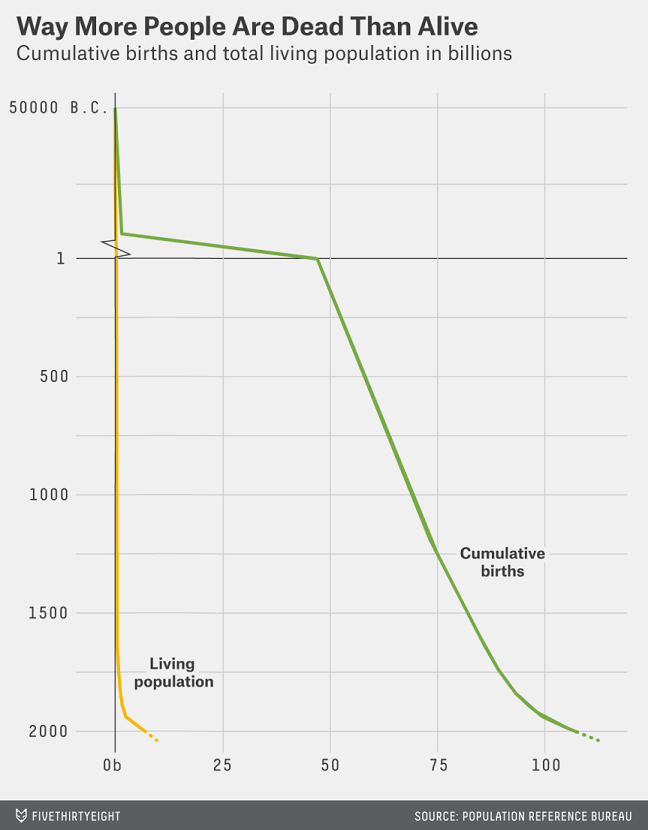Dear Shannah,
Dear Mona,
Assuming that all who expire are promoted to a peaceful afterlife, what would the demographics of heaven be?
Shannah, 27, San Francisco
I don't know much about the afterlife, but that's OK since your question kind of boils down to: "How many people have ever died?" There I can get you some answers. But first I want to start with a bit of expectations management. When it comes to the demographics of the dead, I won't be giving you any numbers to two decimal places. This is kind of like a "guess how many jellybeans are in the jar" competition. If I'm smart about my methodology, I can get pretty close to a decent answer, but it's still a speculative estimate. Here's what I've got: Roughly 100,825,272,791 people have ever died. Let's call it 100.8 billion if you're struggling to read a number that long.
That figure comes with help from Carl Haub, a senior demographer at the Population Reference Bureau, a nonprofit organization that studies population trends. Haub, whom I spoke to by phone last week, has been researching demographics since the dawn of man (that's the scope of his research; he only began his work on this topic in the 1980s). He is one of many people looking to estimate a slightly different figure: the number of people who have ever lived, rather than the number of people who have ever died. Your question, Shannah, leaves out people who are alive today, but most demographers are interested in a cumulative total that includes the current population. It might sound strange, but data on deaths doesn't actually matter for these calculations — we're just interested in a cumulative number of births. I'm using Haub's numbers mostly because he's been transparent about his assumptions.
As of 2015, Haub estimates that a total of 108.2 billion people have ever been born in the history of the world. But I'm subtracting about 7.4 billion of them who are alive today to get you the 100.8 billion estimate. That means that 6.8 percent of everyone who has ever lived is alive today. Or, put another way, the dead outnumber the living 14 to 1.
As you might expect, that total number of dead people has grown a lot over time. The U.S. Census Bureau has collected several of the sources for historical world population rates. The estimates differ for two major reasons — the demographers don't all agree about which date to take as the starting point for human life, and they also estimate population growth differently. Haub told me that he takes 50,000 B.C. as his starting point (based on research from the United Nations about when modern Homo sapiens may have first appeared) and assumes that population growth was pretty much constant until 1850 (wars and famine might make that assumption wrong, but who's to really say given the absence of statistics offices in the Middle Ages?). Overall, then, he estimates that the human population grew from two people in 50,000 B.C. to 2.5 billion people in 1950.
As I said earlier (and as you probably guessed), most of those people who have been born are no longer with us. What's really fascinating, though, is how the dead-to-living ratio is expected to change in the future. By 2050, the world's population is expected to grow to 9.7 billion. Which means that in 35 years' time, the living would make up 8.6 percent of those who have ever been born. And the dead would outnumber the living 11 to 1.
If you think those numbers are shaky (and you should, Shannah!), it gets shakier when it comes to more detailed demographics — you can forget about data on things like disability or migration. I tried to look at the basics: age, location and sex.
Finding how old people were when they died is tough when you're taking 50,000 B.C. as your starting point. Unsurprisingly, accurate data on life expectancy throughout human history is pretty scarce, but the numbers that do exist are low. In the Copper Age, between 3500 and 2000 B.C., people were expected to live to about 36 years, while between 4000 and 3000 B.C. in the Neolithic Age, estimates are as low as 17 years. As of 2013, average global life expectancy at birth is 71 years. It seems safe to assume that the demographics of the dead are considerably younger than the demographics of the living.
Then there's where people came from. This involves yet more discussion among historians and anthropologists about whether humans originated in one place at one time or in several places at several times. Countries and continents aside, rural life has become less common — according to the American Association for the Advancement of Science, humans are more urbanized now than at any point in human history. In 1950, just 29 percent of the world lived in cities, but by 2014 that had climbed to 54 percent. Which means that most dead people in human history will be country folk.
Finally, sex. Worldwide, more boy babies are born than girl babies — though the precise sex ratio at birth varies by country. If that had always been the case, then there would be more dead males than dead females — but I can't find any data on global sex ratios in 1850, let alone 50,000 B.C., to know for sure.
Despite millennia with no accurate data, what I can say with some degree of certainty is that you and I, Shannah, (and everyone reading this) are in the minority, given that less than 10 percent of everyone who was ever born is alive today.
Hope the numbers help,
Mona





Well as one gets a bit older, I could say we learn a thing or too. Seems that there are many vacant spots.
Rowan Atkinson, had some inkling,
[Link]
As for the living dead, that is not quite determined yet.